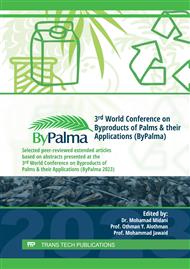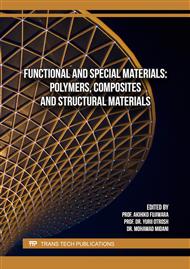[1]
M.M.A. Nassar, K.I. Alzebdeh, N. Al-Hinai, and M. Al Safy, "Enhancing mechanical performance of polypropylene bio-based composites using chemically treated date palm filler," Ind. Crops Prod., vol. 220, p.119237, 2024, doi: https://doi.org/10.1016/j.indcrop. 2024.119237.
DOI: 10.1016/j.indcrop.2024.119237
Google Scholar
[2]
O.Y. Alothman, H.M. Shaikh, B. A. Alshammari, and M. Jawaid, "Structural, Morphological and Thermal Properties of Nano Filler Produced from Date Palm-Based Micro Fibers (Phoenix dactylifera L.)," J. Polym. Environ., 2021.
DOI: 10.1007/s10924-021-02224-0
Google Scholar
[3]
T. Gurunathan, S. Mohanty, and S. K. Nayak, "A review of the recent developments in biocomposites based on natural fibres and their application perspectives," Compos. Part A Appl. Sci. Manuf., vol. 77, p.1–25, 2015.
DOI: 10.1016/j.compositesa.2015.06.007
Google Scholar
[4]
K.I. Alzebdeh and M.M.A. Nassar, "An integrated approach to evaluate mechanical performance of date palm filler reinforced polypropylene," Mater. Today Commun., vol. 35, p.105583, 2023.
DOI: 10.1016/j.mtcomm.2023.105583
Google Scholar
[5]
A.N. Anyakora, "Investigation of Impact Strength Properties of Oil and Date Palm Frond Fiber Reinforced Polyester Composites," Int. J. Curr. Eng. Technol., vol. 3, no. 2, p.493–497, 2013.
Google Scholar
[6]
K.I. Alzebdeh, M. M. A. Nassar, S. A. Awad, and E.-S. I. El-Shafey, "New click chemistry scheme towards improvement of filler/polymer crosslinking in bio-based polymer composites," Polym. Technol. Mater., p.1–14, 2024.
DOI: 10.1080/25740881.2024.2376206
Google Scholar
[7]
L. A. Elseify, M. Midani, L. A. Shihata, and H. El-Mously, "Review on cellulosic fibers extracted from date palms (Phoenix Dactylifera L.) and their applications," Cellulose, vol. 26, no. 4, p.2209–2232, 2019.
DOI: 10.1007/s10570-019-02259-6
Google Scholar
[8]
M.M.A. Nassar, K.I. Alzebdeh, T. Pervez, N. Al-Hinai, and A. Munam, "Progress and challenges in sustainability, compatibility, and production of eco-composites: A state-of-art review," in Journal of Applied Polymer Science, 2021, vol. 138, no. 43, p.1–31.
DOI: 10.1002/app.51284
Google Scholar
[9]
K. Almi, S. Lakel, a. Benchabane, and a. Kriker, "Characterization of Date Palm Wood Used as Composites Reinforcement," Acta Phys. Pol. A, vol. 127, no. 4, p.1072–1074, 2015.
DOI: 10.12693/APhysPolA.127.1072
Google Scholar
[10]
S. Amroune et al., "Tensile Mechanical Properties and Surface Chemical Sensitivity of Technical Fibers From Date Palm Fruit Branches (Phoenix Dactylifera L.)," Compos. Part A Appl. Sci. Manuf., vol. 71, p.98–106, 2015.
DOI: 10.1016/j.compositesa.2014.12.011
Google Scholar
[11]
M.M.A. Nassar, K. I. Alzebdeh, M. M. M. Alsafy, and S. Piya, "Optimizing drilling parameters for minimizing delamination in polypropylene-date palm fiber bio-composite materials," J. Brazilian Soc. Mech. Sci. Eng., vol. 45, no. 11, 2023.
DOI: 10.1007/s40430-023-04528-9
Google Scholar
[12]
N.F. Nabila Farhana binti Abdul Khalil, "Mechanical Properties of Low-Density Polyethylene/Recycled Poly (ethylene Terephthalate)(LDPE/r-PET) Microfibrillar Composite," 2011.
Google Scholar
[13]
H.P.S.A. Khalil, M.A. Tehrani, Y. Davoudpour, A. H. Bhat, M. Jawaid, and A. Hassan, "Natural fiber reinforced poly (vinyl chloride) composites: A review," J. Reinf. Plast. Compos., vol. 32, no. 5, p.330–356, 2013.
DOI: 10.1177/0731684412458553
Google Scholar
[14]
Z. Chen, H.Y. Xie, Y.J. Li, G.E. Chen, S.J. Xu, and Z.L. Xu, "Smart light responsive polypropylene membrane switching reversibly between hydrophobicity and hydrophilicity for oily water separation," J. Memb. Sci., vol. 638, no. June, p.119704, 2021.
DOI: 10.1016/j.memsci.2021.119704
Google Scholar
[15]
G. K. Sathishkumar et al., "Synthesis and Mechanical Properties of Natural Fiber Reinforced Epoxy/Polyester/Polypropylene Composites: A Review," J. Nat. Fibers, vol. 19, no. 10, p.3718–3741, 2022.
DOI: 10.1080/15440478.2020.1848723
Google Scholar
[16]
B. A. Salazar-Cruz, M. Y. Chávez-Cinco, A. B. Morales-Cepeda, C. E. Ramos-Galván, and J. L. Rivera-Armenta, "Evaluation of Thermal Properties of Composites Prepared from Pistachio Shell Particles Treated Chemically and Polypropylene," Molecules, vol. 27, no. 2, 2022.
DOI: 10.3390/molecules27020426
Google Scholar
[17]
J. Ahmad and Z. Zhou, "Mechanical properties of natural as well as synthetic fiber reinforced concrete: a review," Constr. Build. Mater., vol. 333, p.127353, 2022.
DOI: 10.1016/j.conbuildmat.2022.127353
Google Scholar
[18]
W. Tang et al., "Rheological behavior and mechanical properties of ultra-high-filled wood fiber/polypropylene composites using waste wood sawdust and recycled polypropylene as raw materials," Constr. Build. Mater., vol. 351, no. June, p.128977, 2022.
DOI: 10.1016/j.conbuildmat.2022.128977
Google Scholar
[19]
B.O. Orji and A.G. McDonald, "Evaluation of the mechanical, thermal and rheological properties of recycled polyolefins rice-hull composites," Materials (Basel)., vol. 13, no. 3, 2020.
DOI: 10.3390/ma13030667
Google Scholar
[20]
C. Wang, J. Mei, and L. Zhang, "High-added-value biomass-derived composites by chemically coupling post-consumer plastics with agricultural and forestry wastes," J. Clean. Prod., vol. 284, p.124768, 2021.
DOI: 10.1016/j.jclepro.2020.124768
Google Scholar
[21]
K. I. Alzebdeh, M. M. A. Nassar, and N. Al-Hinai, "Development of New Eco-Composites From Natural Agro-Residues and Recycled Polymers," ASME 2020 International Mechanical Engineering Congress and Exposition. Nov. 16, 2020.
DOI: 10.1115/IMECE2020-23536
Google Scholar
[22]
I. O. Oladele, A. A. Adediran, A. D. Akinwekomi, M. H. Adegun, O. O. Olumakinde, and O. O. Daramola, "Development of Ecofriendly Snail Shell Particulate-Reinforced Recycled Waste Plastic Composites for Automobile Application," Sci. World J., vol. 2020, 2020.
DOI: 10.1155/2020/7462758
Google Scholar
[23]
S. Nikmatin, A. Syafiuddin, A. B. Hong Kueh, and A. Maddu, "Physical, thermal, and mechanical properties of polypropylene composites filled with rattan nanoparticles," J. Appl. Res. Technol., vol. 15, no. 4, p.386–395, 2017.
DOI: 10.1016/j.jart.2017.03.008
Google Scholar
[24]
O.Y. Alothman, L.K. Kian, N. Saba, M. Jawaid, and R. Khiari, "Cellulose nanocrystal extracted from date palm fibre: Morphological, structural and thermal properties," Ind. Crops Prod., vol. 159, no. June 2020, p.113075, 2021.
DOI: 10.1016/j.indcrop.2020.113075
Google Scholar
[25]
M.M.M. Alsafy, N. Al-Hinai, K.I. Alzebdeh, E.-S. I. El-Shafey, and M. M. A. Nassar, "Characterization of Extracted Bio-Nano Particles from Date Palm Agro-Residues," J. Mater. Res. Technol., 2024.
DOI: 10.1016/j.jmrt.2024.04.222
Google Scholar
[26]
E. S. Nascimento et al., "All-cellulose nanocomposite films based on bacterial cellulose nanofibrils and nanocrystals," Food Packag. Shelf Life, vol. 29, p.100715, 2021.
DOI: 10.1016/j.fpsl.2021.100715
Google Scholar
[27]
S.M. Mousavi, O. Arjmand, M. R. Talaghat, M. Azizi, and H. Shooli, "Modifying the properties of polypropylene-wood composite by natural polymers and eggshell nano-particles," Polym. from Renew. Resour., vol. 6, no. 4, p.157–174, 2015.
DOI: 10.1177/204124791500600403
Google Scholar
[28]
S.A. Bello et al., "Eggshell nanoparticle reinforced recycled low-density polyethylene: A new material for automobile application," J. King Saud Univ. - Eng. Sci., no. xxxx, 2021.
DOI: 10.1016/j.jksues.2021.04.008
Google Scholar
[29]
K. Zdiri, A. Elamri, M. Hamdaoui, O. Harzallah, N. Khenoussi, and J. Brendlé, "Elaboration and Characterization of Recycled PP/Clay Nanocomposites," vol. 2508, no. 8, p.2370–2378, 2018.
DOI: 10.1080/17518253.2018.1491645
Google Scholar
[30]
M. Salavati and A. A. Yousefi, "Polypropylene–clay micro/nanocomposites as fused deposition modeling filament: effect of polypropylene-g-maleic anhydride and organo-nanoclay as chemical and physical compatibilizers," Iran. Polym. J. (English Ed., vol. 28, no. 7, p.611–620, 2019.
DOI: 10.1007/s13726-019-00728-0
Google Scholar
[31]
K. P. Srinivasa Perumal, R. Boopathi, P. Saravanan, and L. Selvarajan, "Effect of zircon and anatase titanium dioxide nanoparticles on glass fibre reinforced epoxy with mechanical and morphological studies," Ceram. Int., vol. 49, no. 13, p.21667–21677, 2023.
DOI: 10.1016/j.ceramint.2023.03.304
Google Scholar
[32]
M. D. Kiran, H. K. Govindaraju, and T. Jayaraju, "Evaluation of Mechanical Properties of Glass Fiber Reinforced Epoxy Polymer Composites with Alumina, Titanium dioxide and Silicon Carbide," Mater. Today Proc., vol. 5, no. 10, p.22355–22361, 2018.
DOI: 10.1016/j.matpr.2018.06.602
Google Scholar
[33]
R. K. Nayak, K. K. Mahato, and B. C. Ray, "Water absorption behavior, mechanical and thermal properties of nano TiO2 enhanced glass fiber reinforced polymer composites," Compos. Part A Appl. Sci. Manuf., vol. 90, p.736–747, 2016, doi: 10.1016/j.compositesa. 2016.09.003.
DOI: 10.1016/j.compositesa.2016.09.003
Google Scholar
[34]
M. Alsafy, N. Al-Hinai, and K. Alzebdeh, "Production of Date Palm Nanoparticle Reinforced Composites and Characterization of Their Mechanical Properties," ASME Int. Mech. Eng. Congr. Expo. Proc., vol. 3, p.2–9, 2022.
DOI: 10.1115/IMECE2022-95413
Google Scholar
[35]
A. Hachaichi, B. Kouini, L. K. Kian, M. Asim, and M. Jawaid, "Extraction and Characterization of Microcrystalline Cellulose from Date Palm Fibers using Successive Chemical Treatments," J. Polym. Environ., vol. 29, no. 6, p.1990–1999, 2021.
DOI: 10.1007/s10924-020-02012-2
Google Scholar
[36]
M. D. Alotabi et al., "Microcrystalline Cellulose from Fruit Bunch Stalk of Date Palm: Isolation and Characterization," J. Polym. Environ., vol. 28, no. 6, p.1766–1775, 2020, doi: 10.1007/ s10924-020-01725-8.
DOI: 10.1007/s10924-020-01725-8
Google Scholar
[37]
C. Shang, T. Liu, F. Zhang, and F. Chen, "Effect of network size on mechanical properties and wear resistance of titanium/nanodiamonds nanocomposites with network architecture," Compos. Commun., vol. 19, no. September 2019, p.74–81, 2020.
DOI: 10.1016/j.coco.2020.03.002
Google Scholar
[38]
V. G. Parale et al., "Hydrophobic TiO2–SiO2 composite aerogels synthesized via in situ epoxy-ring opening polymerization and sol-gel process for enhanced degradation activity," Ceram. Int., vol. 46, no. 4, p.4939–4946, 2020.
DOI: 10.1016/j.ceramint.2019.10.231
Google Scholar
[39]
M. Karimi Sahnesarayi, H. Sarpoolaky, and S. Rastegari, "Effect of heat treatment temperature on the performance of nano-TiO2 coating in protecting 316L stainless steel against corrosion under UV illumination and dark conditions," Surf. Coatings Technol., vol. 258, p.861–870, 2014.
DOI: 10.1016/j.surfcoat.2014.07.071
Google Scholar
[40]
A. Zahrouni, A. Bendaoued, and R. Salhi, "Effect of sol-gel derived TiO2 nanopowders on the mechanical and structural properties of a polymer matrix nanocomposites developed by vacuum-assisted resin transfer molding (VARTM)," Ceram. Int., vol. 47, no. 7, p.9755–9762, 2021.
DOI: 10.1016/j.ceramint.2020.12.115
Google Scholar
[41]
S. Haq and R. Srivastava, "Wood Polypropylene (PP) Composites Manufactured by Mango Wood Waste with Virgin or Recycled PP: Mechanical, Morphology, Melt Flow Index and Crystalline Behaviour," J. Polym. Environ., vol. 25, no. 3, p.640–648, 2017, doi:10.1007/ s10924-016-0845-9.
DOI: 10.1007/s10924-016-0845-9
Google Scholar
[42]
V.A. Escócio, E.B.A.V. Pacheco, A.L.N. Da Silva, A.D.P. Cavalcante, and L.L.Y. Visconte, "Rheological Behavior of Renewable Polyethylene (HDPE) Composites and Sponge Gourd (Luffa cylindrica) Residue," Int. J. Polym. Sci., vol. 2015, 2015, doi: 10.1155/2015/ 714352.
DOI: 10.1155/2015/714352
Google Scholar
[43]
P. Beesetty, A. kale, B. Patil, and M. Doddamani, "Mechanical behavior of additively manufactured nanoclay/HDPE nanocomposites," Compos. Struct., vol. 247, no. April, p.112442, 2020.
DOI: 10.1016/j.compstruct.2020.112442
Google Scholar
[44]
B.A. Alshammari et al., "Impact of Hybrid Fillers on the Properties of High Density Polyethylene Based Composites," Polymers (Basel)., vol. 14, no. 16, p.1–15, 2022.
DOI: 10.3390/polym14163427
Google Scholar



